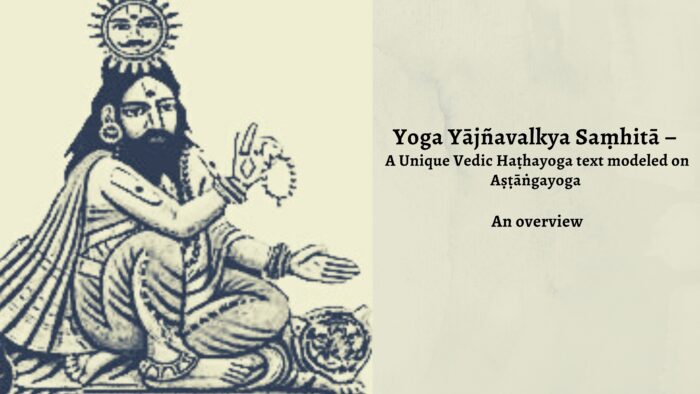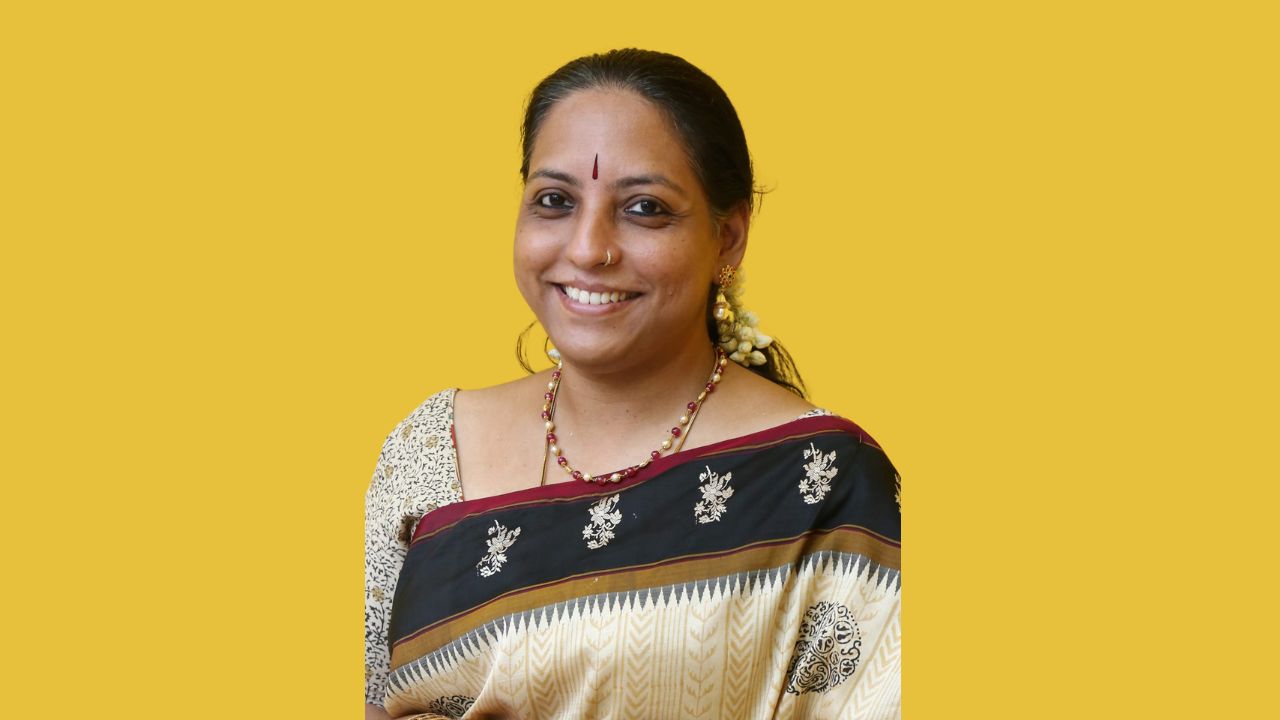Introduction
Yoga Yājñavalkya saṃhitā is a unique text in many respects. It is a 13th Century yoga text[1] which is in the form of a conversation. The participants of the conversation show that men and women were all equal before Yoga and were entitled to practice Yoga even in those times. The Yoga teacher here is husband – Sage Yājñavalkya and the student is his wife – Yogini Gārgī . This conversation between the husband and wife on Yoga also shows that Yoga was practiced by householders and was not a subject matter of monastics alone. Yoga Yājñavalkya saṃhitā is unique as it upholds the need for practices of Vedic rituals and one's duties also – a feature normally not found in hāṭhayoga texts. Also, as the subtitle indicates – though it is considered a Haṭhayoga text , its chapterization is based on the Aṣṭāṅgayoga of Sage Patañjali. Thus it can be seen that this text is a confluence of many unique ideas and approaches. A systematic overview of this text is attempted in this write up. -
Chapterization
There are twelve chapters in this work comprising 463 verses (as per the KYM edition).The chapterization is as follows -
- Chapter 1 – Introduction to the text & Tradition- 10 Yamas
- Chapter 2 – Niyamas (10)
- Chapter 3 – āsanas (8)
- Chapter 4 - Types of Nāḍīs, places and functions of prāṇas
- Chapter 5 - Nāḍīśodhana - Means for Purifying the Nāḍīs
- Chapter 6 – Prāṇayāmas (11)
- Chapter 7 - Pratyāhāras (5)
- Chapter 8 –Dhāraṇās (6)
- Chapter 9 - Dhyāna - (7)
- Chapter 10 - Samādhi
- Chapter 11 – On Performance of Nitya Karma
- Chapter 12 – Review and Final Teachings
Chapter-wise Summary of the text is attempted in this article by creating clustering of related verses.
Commencement of Conversation and Yamas - Chapter 1
The text commences by introducing Sage Yājñavalkya with 24 qualities. The qualities include, that he is – omniscient, the one who is always in a meditative state, the one who has controlled his senses and anger etc ., Gārgī salutes and requests such a Sage Yājñavalkya to speak about the Yoga with all its limbs in detail.(verses 1-9).
It should be noted that Sage Yājñavalkya and Gārgī are mentioned as husband and wife (Verse 1.42) . Sage Yājñavalkya meditates upon Lord Nārāyaṇa and states that he will speak about the knowledge of Yoga that he attained from Lord Brahman. The Sage mentions that Lord Brahman also taught Pravṛtti (following Vedic way of life with worldly attachments that leads to rebirth) and Nivṛtti (following Vedic way of life bereft of worldly desires towards attaining knowledge which leads to liberation). Towards attainment of liberation the practice of Vedic way of life in a dispassionate manner and Yoga is essential. (Verses 10 -40).
The term Yoga is defined in this context as the union of the jīvātman and paramātman (verse 43) and the practice of aṣṭāṅgayoga leads to that union (along with dispassionate performance of one’s duties and Vedic injunctions (Karma)) (Verses 41-48).
After this, the first limb of the aṣṭāṅgayoga, Yama is enumerated and defined. It is interesting to note that this text enlists ten Yamas, five more than that of Pātañjalayogasūtra. The ten Yamas presented herein are - Ahiṃsā (nonviolence), Satya (truth), Asteya (non-stealing), Brahmacarya (celibacy), Dayā(compassion), ārjava(straightforwardness), Kṣamā(forgiving nature ), Dhṛti(fortitude), Mitāhāra (moderate diet) and Śauca(cleanliness). (verses 49-69). Thus ends chapter one.
Niyamas - Chapter 2
Following Yamas in the first chapter, the entire second chapter is devoted to the enumeration and definition of Niyamas. Here also, 10 Niyamas are presented, five more than that of Pātañjalayogasūtra. The Niyamas presented herein are - Tapas (austerities/self-discipline), Santoṣa (contentment), āstikya(believing nature in puṇya and Papa), Dāna(charity), Īśvara-pūjana[2], Siddhānta-śravaṇa (Listening to/learning the doctrines/scriptures), Hrī(shyness in doing sinful deeds), Mati(faith in the path of the śāstras), Japa(repetition of the Mantras) and Vrata((specific) Tools to attain the puruṣārthas given by the teacher) (verses 1-19).
Āsanas - Chapter 3
In this chapter eight āsanas are enumerated and defined. Unlike Haṭhayogapradīpikā where benefits of āsanas are also described, no benefits of practice of āsanas are presented. The eight āsanas are - Svastikāsana, Gomukhāsana, Padmāsana, Vīrāsana, Siṃhāsana, Bhadrāsana, Muktāsana and Mayūrāsana. It is worth noting that the first seven are seated āsanas and the last one is balancing with hands.
Prāṇayāma - Chapter 4, 5 and 6
It is worth noting that these three chapters that are at the heart of the text, are devoted to discussing concepts related to Prāṇayāma. Types of Nāḍīs, places and functions of prāṇas, Nāḍīśodhana and other Prāṇayāma techniques are discussed respectively in these three chapters.
Chapter 4 - Types of Nāḍīs, places and functions of prāṇas - It is mentioned in this chapter that in a non-practitioner of Yoga, Prāṇa pervades the 96 aṅgulas (finger breadth) of the body and also gets dissipated to 12 aṅgulas outside the body. This dissipation of Prāṇa leads to various illnesses. By the practice of Yoga and also be the channelizing prāṇa through Jaṭharāgni this dissipation is avoided and prāṇa is brought within the frame of human body which leads to healthy life. (Verses 1-13).
Following this, the exact place of jaṭharāgni, Kanda (the hub of the Nāḍīs) and the position and fabric of Kuṇḍalinī are also discussed (Verses 13-25).
After this, 14 Nāḍīs in the body are described elaborately. The 14 Nāḍīs are - iḍā, piṅgalā, suṣumnā, sarasvatī, vāruṇī, pūṣā, yaśasvinī, hastijihvā, viśvodarā, kuhū, śaṅkhinī, payasvinī, ālambusā, gāndhārī (Verses 26-46).
This chapter closes with the discussion on the names, position and functions of ten Vāyus that traverse the Nāḍīs. The ten Vāyus are - prāṇa, apāna, vyāna, udāna, samāna, nāga, kūrma, kṛkara, devadatta, dhanañjaya. (Verses 47-71).
Chapter 5 -Nāḍīśodhana - This chapter continues the discussion related to prāṇayāma. Gārgī, the student wants Sage Yājñavalkya to teach her the practice of Nāḍīśodhana for cleansing the Nāḍīs. (Verses 1-3).
Interestingly, before describing the technique of Nāḍī-śodhana, various prerequisites are mentioned by Sage yājñavalkya. This includes choosing a place for practice that is clean, preferably a tapovana (a forest for meditation), where there is not too much sunshine and wind. Along with this, it is also emphasized that one should not fail in performing one’s obligatory (Vedic) duties before sitting for practice and so on. (Verses 4-10).
It is also stated that a practitioner should be seated on kuśa-grass, seated with his back erect, facing North or East and he/she should utter prayers to guru and personal god. (Verses 11-15). After this comes the elaboration on the technique of practice.
The technique described herein is not merely a step by step instruction of breathing, it also involves mental visualization. The technique is as follows - One should inhale through iḍā (left nostril) and hold the breath meditating upon the jaṭharāgni with flames, Then exhalation has to be done through piṅgalā (right nostril) with mental repetition of Ram/ ‘रम्’ sound). After this, inhalation has to be done through piṅgalā. Then one should hold the breath (visualization is not mentioned here). Then finally exhalation has to be done through iḍā (left nostril). This completes one cycle of Nāḍī-śodhana.
It is also stated here, that attainment of purification of the Nāḍīs may take anywhere from, three to four months to three to four years (depending upon the effort put in by the practitioner). It also advised that during the Sandhyā period (2 conjunctions of the day and night - morning and evening) 6 cycles of Nāḍī-śodhana has to be practiced. The chapter ends by stating that - lightness in body, glow of jaṭharāgni, manifestation of Nāda are indicators for success of the practice and also the extent of practice (Verses 12-21)
Chapter 6 - Prāṇayāma techniques - After the preparatory discussion on Nadis, prāṇas and cleansing practice of Nāḍīśodhana, this chapter discusses eleven prāṇayāma techniques. The first technique that is described is Candra-bhedana.[3] (Inhalation through the left nostril - holding the breath within - then exhalation through the right nostril - is the technique) Here the duration of Inhalation, Retention of the breath and exhalation is respectively 16-64-32 Matras(counts). It is to be noted that the classical ratio of breathing - 1:4:2 emerges from this description. Immediately after this - Sūryabhedana technique is also presented (Inhalation through right nostril - retention of breath within - exhalation through the left nostril) (Verses 1-10).
After this, the need to use mantras during prāṇayāma is emphasized. Both Vedic and Non-vedic Mantras are prescribed herein. Vedic Mantras refers to Gāyatrī and Prāṇava and Non vedic Mantras refers to Mantras on divinities like Śiva Viṣṇu etc. The need to practice prāṇayāma thrice daily is also emphasized. (Verses 11-23).
The next set of verses describe the indicators of progress in prāṇayāma including experiencing sweat initially and trembling in middle stages and ability to levitate when one advances further. The description of Sahita and kevala kumbhakas are also presented herein (Verses 23-34).
After this, a set of six prāṇayāma techniques are prescribed for therapeutic purposes. The six techniques are as follows - 1) Inhale and hold the breath within with focus on navel, tip of the nose and Tip of the toes. 2) (śītalī)[4] 3) Inhale and hold (breath within) with focus in kuṇḍalinī 4) Inhale with śītalī technique – hold the breath - focus on the base of the tongue. 5) Inhale through the left nostril with focus in between eyebrows 6) Inhale with both nostrils and hold with focus on navel region.
It is to be noted that in these practices, other than technique where śītalī is involved, it is not specified as to whether inhalation is to be done by one nostril or both nostrils (it seems, the teacher can decide appropriate inhalation mode depending upon the nature of the seekers’s body condition). In describing these techniques, exhalation is not mentioned, which has to be inferred. Depending upon the region of focus of holding the breath presented in the above techniques, the following benefits are presented - Overcoming - various chronic diseases (in the respective regions) & diseases of the abdomen, attainment of long life, attainment of lightness of the body, overcoming tiredness and thirst, good eloquence etc (Verses 35-48).
After this a Nādānusandhāna[5] technique is prescribed where inhaling and holding the breath focusing on the (crown of the) head region is advised. By constant practice of this, it is stated, that prāṇa enters suṣumnā and various anāhata (unstruck Yogic) sounds including sounds of conch, rumbling of clouds are heard (within). This leads to great happiness and this is an indicator of Vāyu-vijaya (conquest over air) (Verses 49-57). This is followed by the description of an advanced Kuṇḍalinī Sādhana.
A practitioner is advised to be seated in Siddhāsana. In this position inhaling (mental) chanting of Om is prescribed and retention of breath within is advised with focus in Navel region. Practice of this is gradually said to lead to the conquest of jaṭharāgni resulting in success with Kuṇḍalinī (awakening). Interestingly, it is mentioned here that this practice can be done by all, with no gender difference (Verse 57-73).
Finally, it is mentioned that mastery in these practices leads to capability to voluntarily shed the body by channelizing prāṇa to move out through Brahmarandhra (aperture in the crown of the head). But, as is characteristic of this text, this chapter ends finally with an advice that one should always perform one’s duties and obligatory (Vedic) Karmas (Verses 74-81).
[1] Encyclopedia Of Indian Philosophy Volume 12: Yoga India's Philosophy Of Meditation, Gerald Larson & Ram Shankar Bhattacharya , pg.10 , 2008
[2] It is interesting to note that īśvarapūjanais described in two ways. the first description is - Worshiping divinities like Lord Viṣṇu or such other divinities with a sense of surrender according to one’s capability. The second definition of īśvarapūjana is - Having a pure heart, having a speech that is not maligned by falsehood and non-harming any being physically.
[3] It is to be noted that the text does not give the nomenclature of any prāṇayāma technique including Candrabhedana, Sūryabhedana etc. The technique is merely described . The nomenclatures are used by the author of this article for compactness of description and also assuming some familiarity on Yogic techniques on the part of the readers.
[4] inhaling through mouth with rolled tongue
[5] It is interesting to note here that Nādānusandhāna is presented as part of Rajayoga in Hathayogapradeepika, whereas in this text it is included under prāṇayāma itself.
In the next (part-2) post, overview of rest of the six chapters (Chapters 7-12) that discuss pratyāhāra, dhāraṇā, dhyāna & samādhi will be presented.





